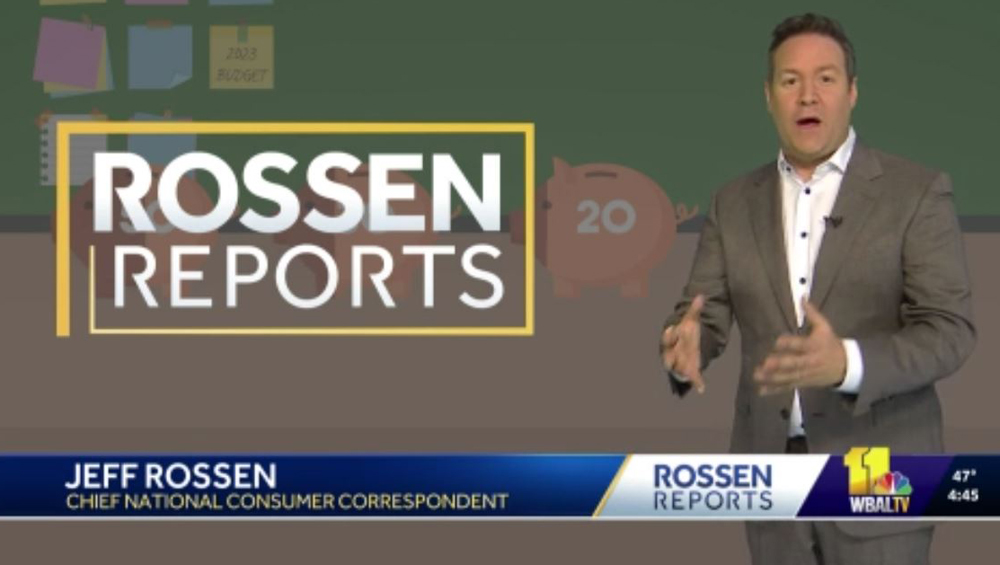
TV Groups Turn To Solutions Journalism, And Viewers Lean In

In Louisville, Ky., soon after the killing of George Floyd sparked protest cries of “defund the police” in 2020, the Gray-owned NBC affiliate WAVE reported how one Kentucky police department hired a social worker instead of an additional officer, which saved the town money and helped the agency serve its community in new ways.
When the CDC announced a rise in STD transmission in 2021, a Graham national team produced a story about ways people can help stop the spread. Last year in Austin, Texas, a few weeks after the Uvalde school shooting tragedy, Nexstar-owned KXAN profiled a school training program launched in Colorado to prevent mass shootings. And when the calendar flipped to 2023, Hearst’s Chief National Consumer Correspondent Jeff Rossen explained the “50-30-20” rule for better personal budgeting in the new year.
The through line between these otherwise disparate stories — from local newscasts and national broadcasts of various groups, appearing on their digital and linear platforms and running across topical and tonal spectrums — is that they are part of an emerging TV news trend. In “solutions journalism,” reporters don’t simply deliver the news. They help solve everyday problems their viewers face.

David Lieberman
“It’s the antidote to ‘if it bleeds it leads,’” says David Lieberman, associate professor of professional practice in media management at The New School. When consumers watch solutions journalism, he says, they think to themselves, “This is news I can use,” and it provides them “a sense of empowerment.”
He adds: “It’s relevant, it’s optimistic, it doesn’t leave them feeling down.”
Tough Reporting By Nature
Something solutions journalism is not, according to its champions, is fluff.
“This is not soft reporting,” says James Finch, VP of news services at Gray Television, which has produced a number of solutions journalism stories throughout the group. “As journalists, our primary concern should be the public, people we serve. If we know that the audience does not like persistent problems, then we should be hunting for solutions.”
Lieberman says the best practices of good journalism are also those of good solutions journalism: “Being skeptical, giving conflicting points of view, raising tough questions, showing the relevance.”
Gray recently formed a team to train its reporters in solutions journalism and launched an internal website containing courses on how to produce such stories. Finch says one features an acronym-based teaching tool that communicates Gray’s four pillars of solutions journalism. Always hearkening back to “PEEL,” Gray reporters crafting solutions journalism pieces will remember to present a “problem,” “explain” a solution and provide “evidence” that it may work in a community, while also describing its potential “limitations.”
Among the solutions journalism packages at Gray that Finch is most proud of is Bridging The Great Health Divide, a series of dozens of stories about health disparities in the Delta and Appalachian regions. The pieces, produced with an eye toward enacting change in those communities, were generated in 2022, with contributions from about 30 Gray markets, Finch says.
Solutions Journalism Network
The project was buoyed by the Solutions Journalism Network, which provided the initial training of Gray production teams in solutions journalism. The nonprofit was launched 10 years ago by two New York Times writers, David Bornstein and Tina Rosenberg, who worked on the opinion section’s “Fixes” column, devoted to problem solving. Courtney Martin, an activist and writer who’d frequently contributed to “Fixes,” also helped launch the organization.

Tina Rosenberg (Emmanuel Upegui photo)
Rosenberg says that she and her cofounders wanted “to share the methodology for doing that kind of reporting.” They quickly found that “journalists want to do solutions reporting. They’re tired of reporting the same problem story over and over again,” Rosenberg says, adding that consumers are equally as fatigued by this approach to news delivery.
The Solutions Journalism Network (SJN) now has a staff of around 50, Rosenberg says, and has worked with upward of 700 different news organizations in the U.S. and abroad and at least 25,000 journalists.
A Longer Trajectory
But solutions journalism actually predates the SJN by a couple decades. Bill Dodd, author of Solutions Journalism: News at the Intersection of Hope, Leadership, and Expertise, says much of its DNA is tied to the “public” or “civic” journalism movement of the 1990s. That initiative focused on community issues and aimed to activate citizens, making them more informed and politically energized.
Solutions journalism has since evolved, with print publications initially more apt to adopt it because of the space flexibility their medium allows. Describing a problem, its effects on a community, the ways individual or institutional changes might be enacted on a sustainable level and the possible shortcomings of a presented solution is awfully difficult to do in 90-second TV news blocks.
“It’s very rigorous, investigative and evidence based … even to the extent of being quite critical and antagonistic,” Dodd says of the best solutions journalism.
TV News’ Embrace
TV news groups are buying in.
“The demands of TV news to do something visually interesting can sometimes make it difficult to get out of the rut that a lot of TV news is in,” Rosenberg says. She sees repetition in the photography of TV news: “Stand-ups in front of accident zones and shooting zones.” But, she says, “It seems to me like more and more news organizations are breaking out of that.”
 In addition to “Rossen Reports,” Hearst’s national segment behind the “50-30-20 rule” of personal budgeting and other solutions-focused stories, the company also produced “Forecasting Our Future,” a dynamic series of content covering weather and climate change. Hearst’s SVP of News, Barb Maushard, says the initiative “explores problems and solutions,” and that the company’s journalists are committed to helping their audiences “navigate the challenges and changes of their daily life.
In addition to “Rossen Reports,” Hearst’s national segment behind the “50-30-20 rule” of personal budgeting and other solutions-focused stories, the company also produced “Forecasting Our Future,” a dynamic series of content covering weather and climate change. Hearst’s SVP of News, Barb Maushard, says the initiative “explores problems and solutions,” and that the company’s journalists are committed to helping their audiences “navigate the challenges and changes of their daily life.

Barb Maushard
“We do our job best when we go beyond the surface, explain the ‘why’ of a story, help the audience understand the impact and explore solutions to complex problems,” Maushard says. “Coverage that explores divisions and provides outlets for conversation and education can strengthen communities. It’s not our job to tell viewers what to do, but we serve them well when we showcase successful outcomes to various challenges and provide tools to help viewers address their needs.”
ABC Owned Stations are building solutions journalism stories from data collected from its Neighborhood Safety Tracker, technology that gleans safety-centric public information from city and state agencies. The group’s KTRK Houston has found the tracker particularly helpful in its pursuit of solutions journalism packages. The station recently produced one story about the successful efforts of community members to lower crime in their neighborhood, after the tracker revealed data supporting the drop. In another piece, the tracker identified car-part theft hotspots and the ways automobile owners can more effectively protect their vehicles.

John Kelly
John Kelly, director of data journalism at ABC Owned Television Stations, says these types of stories, leveraged by Neighborhood Safety Tracker data, as opposed to a “run-of-the-mill crime report,” create “better informed residents” who “can make decisions that might reduce” safety risks and “debunk” ideas that a certain neighborhood is “crime-ridden.”
Both observations reflect two key components of solutions journalism’s value proposition to TV news outlets. Author Bill Dodd says “the starting point for solutions journalism” is data journalism, which has become en vogue in its own right because presenting hard data in a news segment inherently displays station transparency, while helping solidify trust in the reporter and, by proxy, their newsgroup’s brand. And, particularly for local stations, solutions journalism provides opportunities to cover marginalized communities that deal with crime, poverty and other challenges in more positive ways.
Graham’s Solutionaries

Catherine Badalamente
Catherine Badalamente, president and CEO of Graham Media Group, says many TV news brands “have a really bad rap just for reporting on all the bad things that happen in certain communities, which is really not fair.” She observes that solutions journalism doesn’t necessarily have to be “good news,” but “news that’s good for you,” the viewer.
“It can be about something that’s really challenging, but also trying to find the people that are trying to fix it [and] improve their communities,” she says.
After learning about solutions journalism three years ago in conversation with people from the Knight Foundation and the Solutions Journalism Network, Badalamente gathered the Graham digital team to devise some solutions-focused programming. The result, initially piloted at WKMG Orlando, Fla., before becoming primarily a national YouTube feature, was Solutionaries, a series that, according to its web description, “highlights creative thinkers and doers in communities focused on making a positive impact.”

Jeremy Allen
“Our intention is to be intentional about providing a positive outlook and not having people come away from our stories thinking that there is no answer and feeling hopeless, instead knowing that there is support, there are people helping and that there are solutions,” says Jeremy Allen, the executive producer of Solutionaries who, like others who work on the show, engaged in SJN training in the run up to its launch. “People are clamoring for this type of material.”
Solutionaries has provided plausible solutions to everything from work burnout to school absenteeism, roadside dangers to hurricane home damage. Badalamente, who says solutions journalism is important to her and something she believes in, has overseen the recent launch of the Solutionaries podcast — an indication of the initiative’s success.
Allen says the audience’s response, based on YouTube comments and other conversations he and his team have had, has been “very positive.
“There’s an appreciation for at least an effort to find something positive to report about or to offer an answer to problems instead of offering more problems to problems,” he says.
But Allen adds that a “major part” of solutions journalism is “poking holes in the solutions we’re offering.” It’s an acknowledgement that there may be imperfections to a given solution that’s been presented, and that it may not solve everyone’s problems, he says. “But it’s a thing that is moving the needle in a positive direction,” he continues. “The more transparent and honest we are about knowing the flaws and limitations there are in our reporting, the more connective tissue that forms between us and our audience.”
CBS And Nexstar Tackle Solutions

Chad Cross
CBS Television Stations is also among the news groups that have recently committed to solutions journalism. Reporters are being trained internally, using the SJN approach, says Chad Cross, VP of content development.
“Our focus is to serve our communities so that we’re not just presenting reports every day about problems happening within them, but exploring how those problems are being addressed,” Cross says. “We’re looking for ways to report on the resiliency of communities as they respond to serious issues.”
Last fall, the CBS Local News Innovation Lab produced Handcuffs in Hallways, an investigative project focused on arrests of elementary-age schoolchildren. Cross told TVNewsCheck in November that an important component of the series was the various solutions to the problem collected from the 14 markets involved in its production. The company also examined possible solutions to school shootings in another series, Kids Saving Kids, and Cross says more solutions journalism content is on the way, including an upcoming group-wide project covering youth mental health programs in various markets.
“When you think about having 14 newsrooms across the country generating a solutions story and then we share that story, you can have an audience in Las Vegas learn about something working in San Francisco,” Cross says. “Maybe that starts a conversation about what’s going on where you live.”
Another group producing more solutions journalism stories is Nexstar with its KXAN Austin, Texas, becoming particularly prolific in the category. Branded as a home for in-depth investigative journalism, KXAN has produced a number of solutions-oriented stories, even devoting an entire landing page on its website to them.

Eric Lassberg
“How many times have you seen an investigation and at the end you’re [thinking], ‘Thank you for telling me this horrible problem, but now what?’” says KXAN GM Eric Lassberg. “We just felt like going toward a solution on some of these big issues and crafting the journalism in that way would be the perfect way to build upon our brand.”
Though it’s difficult to quantify the precise impact KXAN’s devotion to solutions journalism has had, Lassberg says the station has received numerous emails from viewers and heard from people in public indicating that it’s serving them well. He also says the station’s ratings lead in the market continues to expand, while some of its solutions journalism stories have led to policy changes and national and regional Murrow Awards.
To achieve all this, KXAN did not need to break its budget.
“We can’t call corporate and say, ‘We want to add five bodies.’ It just doesn’t work that way anywhere,” Lassberg says. “You’ve got a finite amount of resources and you’re just going to have to allocate more of those towards the investigative brand.”
 According to Lassberg, KXAN also applied for an SJN grant that included on-site newsroom training, as well as funding and additional resources for the station’s first solutions journalism project, which became “Save Our Students: Solutions for Wellness & Safety,” a series centered around the mental health of young people in education settings.
According to Lassberg, KXAN also applied for an SJN grant that included on-site newsroom training, as well as funding and additional resources for the station’s first solutions journalism project, which became “Save Our Students: Solutions for Wellness & Safety,” a series centered around the mental health of young people in education settings.
Solutions Journalism Abroad
Though its roots may reside stateside, solutions journalism is becoming popular outside the U.S. as well. The BBC has developed a few different solutions journalism programs, including People Fixing the World, primarily a podcast that sometimes features video content, too.
Dougal Shaw, who worked as a producer on People Fixing the World for 18 months, says the stint was “the most rewarding of my career so far, both in terms of creativity and personal satisfaction, because of the audience reaction.”
He cites a couple of stories — about circular runways at airports and a Swedish shopping mall with stores that sell only items made from recycled materials — that he says each earned nearly 50 million views and tens of thousands of likes on social media.
“You are used to negative comments on social, but there was a torrent of positive energy,” Shaw says. “People were curious about the solutions and wanted to applaud and share them. There was clearly an appetite for this type of story.”
Shaw likes working on solutions journalism so much that even after leaving People Fixing the World and working for the BBC’s business news team, he developed a series, CEO Secrets, where business leaders often share problem-solving advice. He also just spun CEO Secrets into a new book of the same name.
Gaining Momentum
Solutions journalism might not become a driving production force behind regular top stories in newscasts, replacing segments about safety and other issues that, while unsettling, are also important to viewers. But sources for this story roundly believe solutions journalism will continue to spread throughout the industry. There’s data to suggest it should.
In 2020, the Solutions Journalism Network commissioned a SmithGeiger study about the impact of solutions journalism on newsrooms. “[T]here was a significant lift in key news consumer responses to the stories that demonstrated core principles of solutions journalism,” said an SJN press release about the study. This translated into deeper audience engagement and interest, particularly among younger viewers, as well as an increased desire on the part of consumers to become more actively involved in local concerns. Solutions journalism, the report said, also strengthens accountability. (The report posed: “If Cleveland finds a solution to a problem, a reporter in Cincinnati can run the story and ask Cincinnati authorities: Why aren’t you trying this?”)
In today’s multichannel ecosystem, TV news groups can also develop strong, multi-faceted solutions journalism stories without worrying about such strict time regulations that come with linear broadcasts. If they want to produce solutions journalism for traditional TV stations, sources suggest publishers consider going the series route, which will allow reporters to unpack all the details required in solutions-oriented stories.
“We’re pretty good at finding problems and presenting them. This is just a different way of working that muscle,” says Gray’s Finch. “Ultimately, the audience is like, ‘I want this to stop. I want to see a brighter day.’ We’re just helping them to get there.”



































Comments (1)
Joe Bottoms!! says:
March 14, 2023 at 6:59 am
What a joke ..There are no journalists left ……..